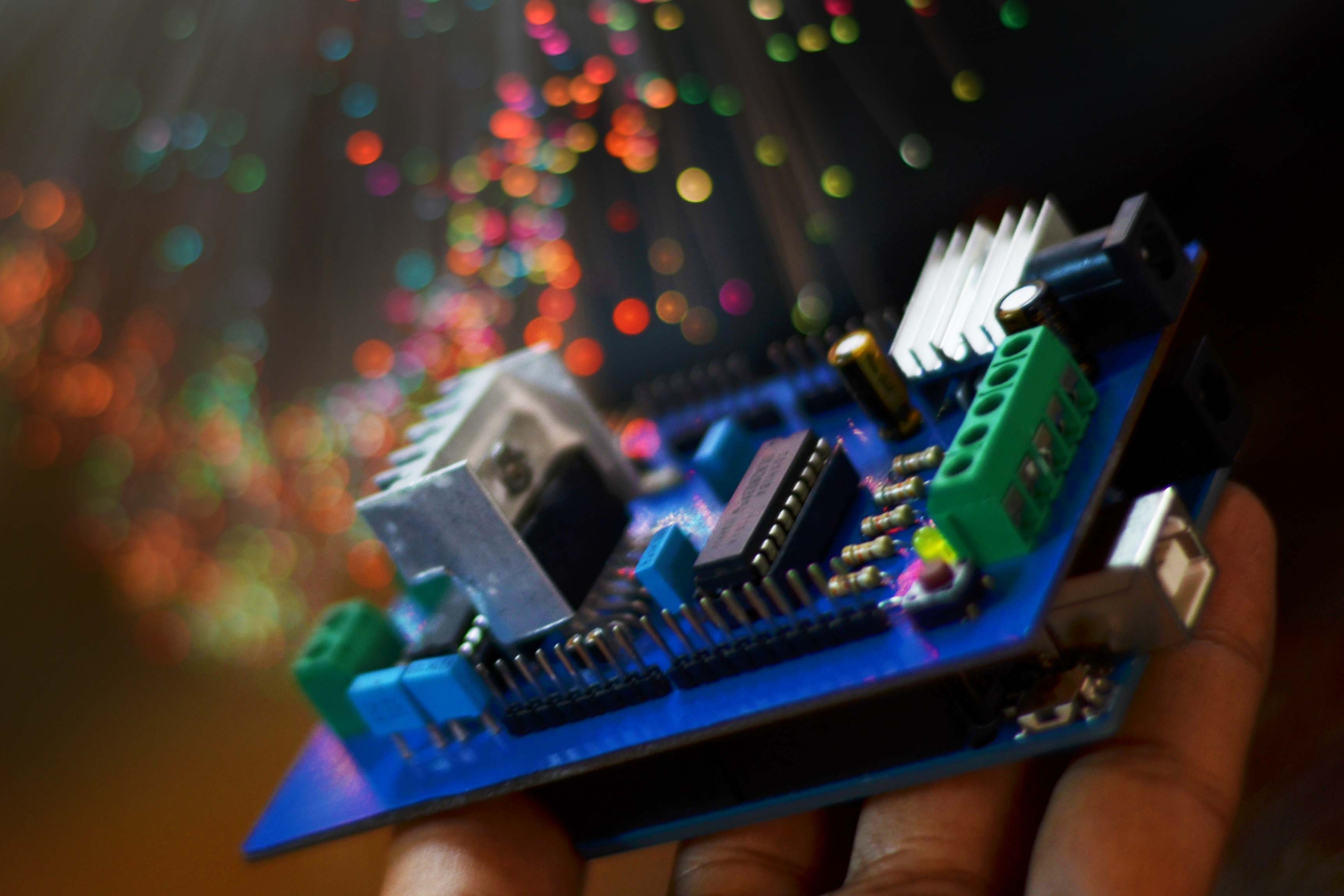| Section 1 : Introduction to PCB designing concepts |
| a. |
Introduction and brief history |
| |
I. |
What is PCB |
|
|
| |
II. |
Difference between PWB and PCB |
|
|
| |
III. |
Types of PCBs |
|
|
| |
IV. |
Single Sided (Single Layer) |
|
|
| |
V. |
Multi-Layer (Double Layer) |
|
|
| |
VI. |
PCB Materials |
|
|
| b. |
Trends in PCB designing |
| |
I. |
Older PCB Method |
|
|
| |
II. |
PCB Designing Using Graph Paper |
|
|
| |
III. |
Making a hand drawn PCB |
|
|
| |
IV. |
Using Computer for EDA |
|
|
| c. |
Introduction to electronic design automation(EAD) |
| |
I. |
Brief History of EDA |
|
|
| |
II. |
Latest Trends in Market |
|
|
| |
III. |
How it helps and Why it requires |
|
|
| |
IV. |
Different EDA tools |
|
|
| |
V. |
Introduction to SPICE and PSPICE Environment |
|
|
| |
VI. |
Introduction and Woriking of PROTEUS |
|
|
| Section 2 : Component introduction and their categories |
| a. |
Types of components |
| |
I. |
Active Components |
|
|
| |
II. |
Diode |
|
|
| |
III. |
Transistor |
|
|
| |
IV. |
MOSFET |
|
|
| |
V. |
LED |
|
|
| b. |
Component package types |
| |
I. |
Through Hole Packages |
|
|
| |
II. |
Axial lead |
|
|
| |
III. |
Radial Lead |
|
|
| |
IV. |
Single Inline Package(SIP) |
|
|
| |
V. |
Dual Inline Package(DIP) |
|
|
| |
VI. |
Transistor Outline(TO) |
|
|
| |
VII. |
Pin Grid Array(PGA) |
|
|
| |
VIII. |
Through Hole Packages |
|
|
| |
IX. |
Metal Electrode Face(MELF) |
|
|
| |
X |
Leadless Chip Carrier(LCC) |
|
|
| |
XI. |
Small Outline Integrated Circuit(SOIC) |
|
|
| |
XII. |
Quad Flat Pack(QPF) and Thin QFP (TQFP) |
|
|
| |
XIII. |
Ball Grid Array(BGA) |
|
|
| |
XIV. |
Plastic Leaded Chip Carrier(PLCC) |
|
|
| |
XV. |
Inductor |
|
|
| |
XVI. |
Transformer |
|
|
| |
XV. |
Speaker/Buzzer |
|
|
| Section 3 : Introduction to development tools |
| a. |
Introduction of PROTUEUS ISIS software for schematic entry |
| |
I. |
Brief Introduction of various simulators |
|
|
| |
II. |
Description to Proteus ISIS simulator tool |
|
|
| |
III. |
Hands on practice on available library of components |
|
|
| |
IV. |
Working through wiring and schematic designing |
|
|
| |
V. |
Making New Component Symbols |
|
|
| b. |
Introduction of PROTUEUS ARES software for PCB designing |
| |
I. |
Connecting the schematic From ISIS to ARES for Netlising |
|
|
| |
II. |
Selecting the Components Footprints as per design |
|
|
| |
III. |
Picking and placing the Component |
|
|
| |
IV. |
Making New Footprints |
|
|
| |
V. |
Assigning Footprint to components |
|
|
| Section 4 : Detailed description and practicals of PCB designing |
| a. |
PCB Designing Flowchart |
| |
I. |
Schematic Entry |
|
|
| |
II. |
Netlisting |
|
|
| |
III. |
PCB Layout Designing |
|
|
| |
IV. |
Prototype Designing |
|
|
| |
V. |
Design Rule Check(DRC) |
|
|
| |
VI. |
Design For Manufacturing(DFM) |
|
|
| |
VII. |
PCB Making |
|
|
| |
VIII. |
Printing |
|
|
| |
IX. |
Etching |
|
|
| |
X. |
Drilling |
|
|
| |
XI. |
Assembly of components |
|
|
| b. |
Description of PCB Layers |
| |
I. |
Electrical Layers |
|
|
| |
II. |
Top Layer |
|
|
| |
III. |
Mid Layer |
|
|
| |
IV. |
Bottom Layer |
|
|
| |
V. |
Mechanical Layers |
|
|
| |
VI. |
Board Outlines and Cutouts |
|
|
| |
VII. |
Drill Details |
|
|
| |
VIII. |
Documentation Layers |
|
|
| |
IX. |
Components Outlines |
|
|
| |
X. |
Reference Designation |
|
|
| |
XI. |
Text |
|
|
| c. |
Keywords & their description |
| |
I. |
Footprint |
|
|
| |
II. |
Pad stacks |
|
|
| |
III. |
Vias |
|
|
| |
IV. |
Tracks |
|
|
| |
V. |
Color of Layers |
|
|
| |
VI. |
PCB Track Size Calculation Formula |
|
|
| d. |
PCB materials |
| |
I. |
Standard FR-4 Epoxy Glass |
|
|
| |
II. |
Multifuctional FR-4 |
|
|
| |
III. |
Tetra Functional FR-4 |
|
|
| |
IV. |
NelcoN400-6 |
|
|
| |
V. |
GETEK |
|
|
| |
VI. |
BT Epoxy Glass |
|
|
| |
VII. |
Cyanate Aster |
|
|
| |
VIII. |
Plyimide Glass |
|
|
| |
IX. |
Teflon |
|
|
| e. |
Rules for track |
| |
I. |
Track Length |
|
|
| |
II. |
Track Angle |
|
|
| |
III. |
Track Joints |
|
|
| |
IV. |
Track Size |
|
|
| f. |
Study of IPC Standards |
| |
I. |
IPC Standard For Schematic Design |
|
|
| |
II. |
IPC Standard For PCB Designing |
|
|
| |
III. |
IPC Standard For PCB Meterials |
|
|
| |
IV. |
IPC Standard For Documentation and PCB Fabrication |
|
|
| Section 5 : Lab practice and designing concepts |
| a. |
Starting the PCB designing |
| |
I. |
Understanding the schematic Entry |
|
|
| |
II. |
Creating Library & Components |
|
|
| |
III. |
Drawing a Schematic |
|
|
| |
IV. |
Flat Design / hierarchical Design |
|
|
| |
V. |
Setting up Environment for PCB |
|
|
| |
VI. |
Design a Board |
|
|
| b. |
Autorouting |
| |
I. |
Introduction to Autorouting |
|
|
| |
II. |
Setting up Rules |
|
|
| |
III. |
Defining Contraints |
|
|
| |
IV. |
Autorouter Setup |
|
|
| c. |
PCB design practice |
| |
I. |
PCB Designing of Basic and Analog Electronic Circuits |
|
|
| |
II. |
PCB Designing of Power Supplies |
|
|
| |
III. |
PCB Designing of Different Sensor modules |
|
|
| |
IV. |
PCB Designing of Electronics Projects |
|
|
| |
V. |
PCB Designing of Embedded Projects |
|
|
| d. |
Post designing & PCB fabrication process |
| |
I. |
Printing the Design |
|
|
| |
II. |
Eaching |
|
|
| |
III. |
Drilling |
|
|
| |
IV. |
Interconnecting and Packaging electronic Circuits (IPC) Standards
|
|
|
| |
V. |
Gerber Generation |
|
|
| |
VI. |
Soldering and Desoldering |
|
|
| |
VII. |
Component Mounting |
|
|
| |
VIII. |
PCB and Hardware Testing |
|
|
| e. |
Project work |
| |
I. |
Making the schematic of Acedemic and Industrial projects |
|
|
| |
II. |
PCB Designing of these projects |
|
|
| |
III. |
Soldering and Desoldering of componets as per Design |
|
|
| |
IV. |
Testing and Troubleshoting Methods |
|
|
| Section 6 : Project work and documentation |
| a. |
Project work and documentation |
| |
I. |
Description of Project Development Process |
|
|
| |
II. |
Project Discusion & Allotment |
|
|
| |
III. |
Synopsis Making & Submission |
|
|
| |
IV. |
Practice of De-Soldering & Soldering |
|
|
| |
V. |
Introduction to Hardware Techniues |
|
|
| |
VI. |
Project Completion |
|
|
| |
VII. |
Detailed Project Report Submission |
|
|
| |
VIII. |
Final Project PPT |
|
|
| |
IX. |
Feedback Submission (Written & Video) |
|
|
| |
X. |
Certification Distribution |
|
|







